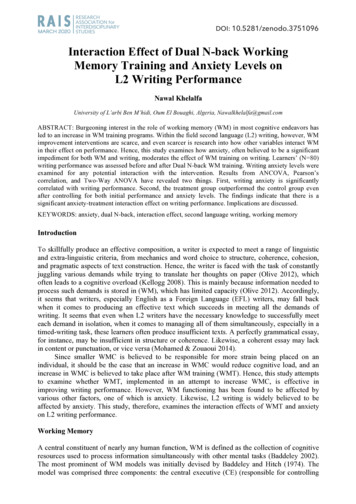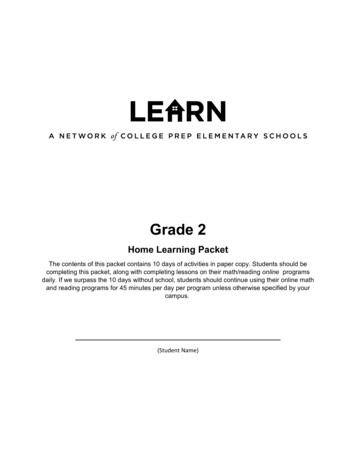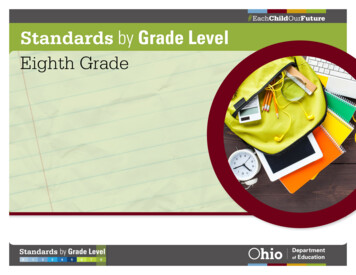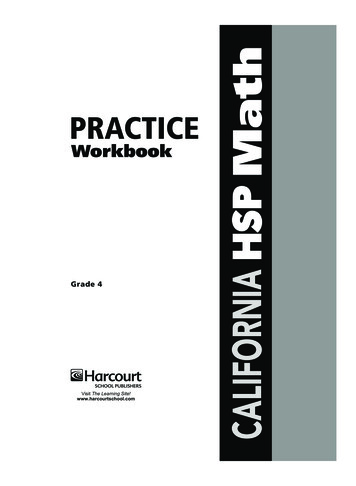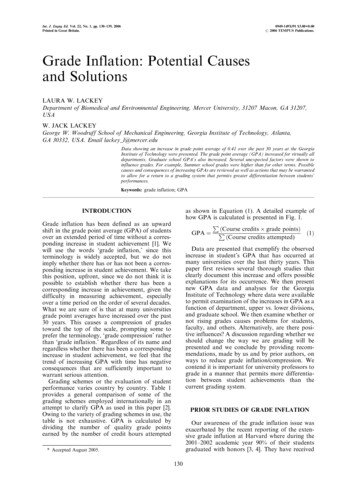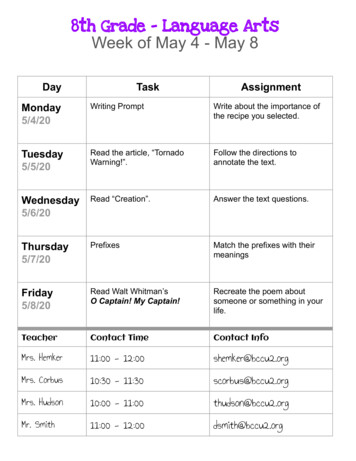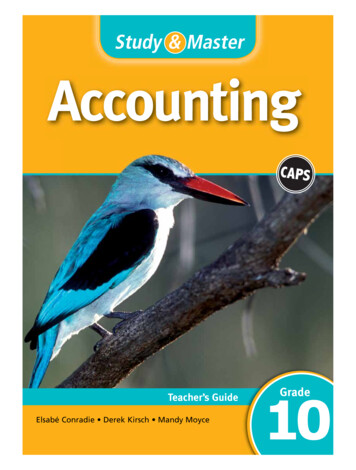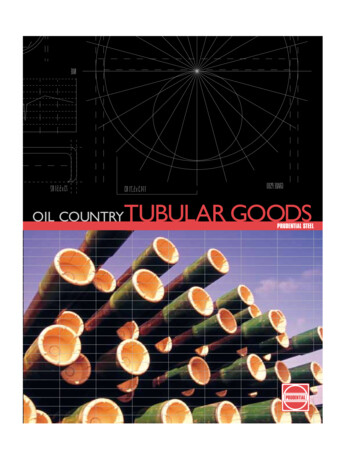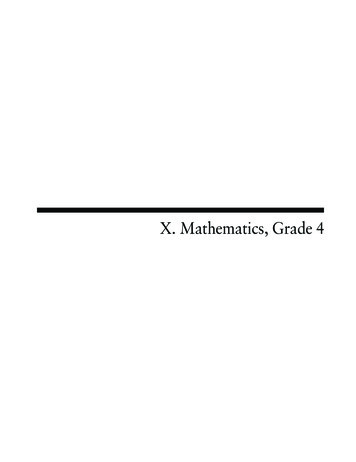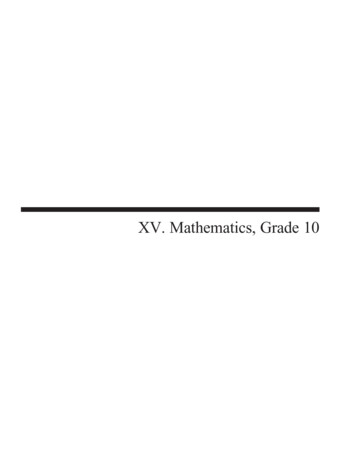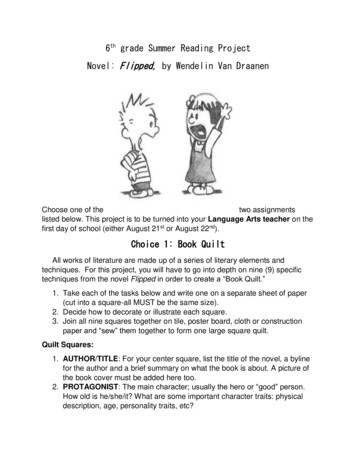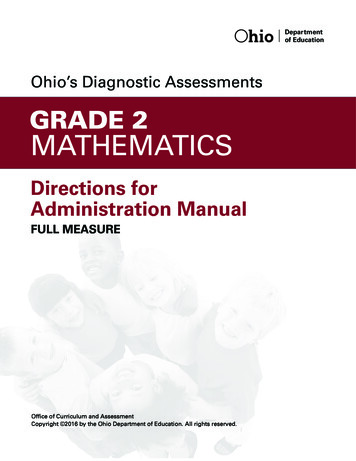
Transcription
Ohio IOhio’ss Diagnostic AssessAssessmentssmentsGRADEGRAADE 2MMATHEMATICSATHEMMATICSDirecDirectionsctions fofororAdministrationManualAdmministration MannualFULL MEASUREOfficeOffice of Curriculum and AssessmentCopyright 2016 by the Ohio Department of Education. All rights reserved.reserved.Depar tmentDDepartmentof Educationof
The Ohio Department of Education does not discriminate on the basis of race, color, nationalorigin, sex, religion, age, or disability in employment or the provision of services.
ADMINISTRATION MANUALIntroductionThis Directions for Administration Manual (DFAM) for the Ohio DiagnosticAssessments contains information on administering the Full Measure.Before administering the Full Measure, Test Administrators (TAs) must review thisDFAM to familiarize themselves with the policies and procedures, and materialsnecessary for conducting the administration.For guidance on statewide requirements for administering and reporting resultsfrom the Ohio Diagnostic Assessments, please refer to the Ohio Department ofEducation website. Go to education.ohio.gov and search key words: DiagnosticAssessments.Third Grade Reading GuaranteeDistricts/schools must administer a reading diagnostic assessment to all studentsin grade one through grade three by September 30 and to all students inkindergarten by November 1 of each school year to meet the requirements of theThird Grade Reading Guarantee. Districts/schools must administer a mathematicsdiagnostic assessment to all students in grades one and two, and a writingdiagnostic assessment to all students in grades one, two and three at least onceduring the school year. All results must be reported in the EMIS data collection.Use of FormatThe Ohio Diagnostic Assessments were developed in two formats: Screener – Kindergarten, one, two, three for reading and writing; andkindergarten, one and two for mathematics. Full Measure - Kindergarten, one, two, three for reading and writing; andkindergarten, one and two for mathematics.A specific format is to be administered at different times of the year to assessspecific skills. The Screener will measure the end-of-year expectations of theprevious year’s standards; the reading Screener will be used to meet therequirements of the Third Grade Reading Guarantee. The Full Measure willmeasure end-of-year expectations of the current grade level.There is no Short Screening Measure for the Ohio Diagnostic Assessments.1
Test Administrator CriteriaThe test administrator must meet this criteria: The person must be an employee of the district or school; The person must hold a current permit, license or certificate issued by theOhio Dept. of Education.If the person providing the accommodation is also administering the diagnosticassessment, then that person must also meet the test administrator criteria.Content 1Number and Operations inBase Ten2.NT.B.392Number and Operations inBase Ten2.NT.B.3103Number and Operations inBase Ten2.NT.A.1b114Number and Operations inBase Ten2.NT.B.4115Number and Operations inBase Ten2.NT.B.4126Measurement and Data2.MD.A.2147Operations and AlgebraicThinking2.OA.C.4Activity 12
PageNumberItemNumber17Domain(s)Standard(s)8Number and Operations inBase Ten2.NT.B.3179Number and Operations inBase Ten2.NT.B.31810Number and Operations inBase Ten2.NT.B.31911Number and Operations inBase Ten2.NT.B.22012Number and Operations inBase Ten2.NT.C.52113Number and Operations inBase Ten2.NT.C.62214Number and Operations inBase 717Measurement and Data2.MD.C.82818Measurement and Data2.MD.C.82919Measurement and Data2.MD.C.83020Operations and AlgebraicThinking2.OA.A.1Activity 2Activity 33
ions and AlgebraicThinking2.OA.C.43522Operations and AlgebraicThinking2.OA.A.13723Operations and AlgebraicThinking2.OA.C.43924Measurement and Data2.MD.A.14025Measurement and Data2.MD.A.24226Measurement and 4629Geometry2.G.A.1Activity 4Students Who Require AccommodationsDefinition of an AccommodationFor Ohio’s Diagnostic Assessments, accommodations are considered to beadjustments to the testing conditions, test format or test administration that provideequitable access during assessments for students with disabilities and students whoare English language learners.Criteria for the Use of AccommodationsAccommodations should: Provide equitable access during instruction and assessment; Mitigate the effects of a student’s disability or English language learner status;4
Not reduce learning or performance expectations; Not change the construct being assessed; Not compromise the integrity or validity of the assessment; For students with disabilities, be documented in the IEP or 504 plan.Special Considerations for the Read-Aloud, Scribe and Mathematical ToolsAccommodations for Students with DisabilitiesAs with all testing accommodations, the read-aloud, scribe and mathematicaltools accommodations should not change the construct being assessed, i.e.,change what is being measured by the task. Therefore, consider these guidelineswhen providing these accommodations: Read-Aloud: The test administrator should consider the read-aloud for thereading diagnostics on an activity-by-activity basis. For example, if theStrand/Topic for an activity is Literature: Key Ideas and Details, then readingthe passage and items in the task will not change what the activity ismeasuring. However, if the Strand/Topic for an activity is Foundational Skills:Phonics and Word Recognition or Foundational Skills: Fluency, then readingany of the activity to the student would change what the activity ismeasuring and therefore should not be read aloud. Scribe: The test administrator should consider use of a scribe for the writingdiagnostics on an activity-by-activity basis. For example, if the Strand/Topicfor an activity is Language: Conventions of Standard English, then use of ascribe would not be appropriate in many cases since writing for the studentwould change what the activity is measuring. However, if an activity is testingmultiple Strands/Topics, for example, Writing: Text Types and Purposes andLanguage: Conventions of Standard English, use of a scribe may beappropriate. Since rubrics for writing activities include multiple skills, use of ascribe in these instances would allow a student who qualifies for theaccommodation to show what they know and can do in areas other thanConventions such as Content, Written Expression and Grammar. The scribeshould write the student’s verbatim response without changing the responsein any way. The student should indicate capitalization and punctuation.Please refer to Appendix C - Protocol for Scribing and Transcribing StudentResponses in Ohio's Accessibility Manual with Appendices for more details.5
Mathematical tools: Calculators are not allowed on Ohio’s DiagnosticAssessments. Students with disabilities may use mathematical tools as anaccommodation to assist mathematical problem solving. These manipulativesallow the flexibility of grouping, representing or counting without numericlabels. Allowed mathematical tools include 100s chart, base 10 blocks,counters and counting chips, cubes, square tiles, two-colored chips andalgebra tiles.There are no special versions (e.g., large print, Braille, English audio CD or foreignlanguage CDs) of the Ohio Diagnostic Assessments.Accommodations for English Language LearnersAllowable accommodations for English language learners (ELLs) on any of Ohio’sDiagnostic Assessments include use of a word-to-word dictionary and extendedtime. Additionally, mathematics tests may be orally translated. The departmentdoes not reimburse for translators for the diagnostic tests. Test administrators shoulddetermine accommodations for ELLs on a student-by-student basis, taking intoconsideration the student’s language acquisition level and familiarity with theaccommodation. For example, a word-to-word dictionary may not be appropriatefor a student with low English language acquisition or who does not use adictionary regularly.For more information on accessibility and accommodations, refer to theOhio’s Accessibility Manual. Go to education.ohio.gov and search keywords:accessibility manual.Test Administration ProceduresBefore the TestMaterials Needed for TestingPlease print these materials from the website. TAs will need this manual. a Student Booklet (one per student) a Student Score Sheet (one per student)6
Teacher Provided Materials Centimeter Ruler Inches RulerThe teacher provided materials are intended to be instructional materials that maybe found in the classroom. It is not the intent to have the teacher purchaseadditional materials.Preparing to Give the TestThe following steps are recommended to prepare for the administration: Collect the necessary materials listed above Review the script to ensure you are familiar with the assessment Check which students are to receive accommodations and make sure thestudents are familiar with the procedure.During the Test AdministrationAdministration Types: Group vs. IndividualThe Ohio Diagnostic Assessment activities have two different administration types:group and individual, or one-on-one.Oral ScriptsTo ensure standardized administration conditions across the state, this manualcontains directions that you will read to students, including oral scripts. Allinformation to be read aloud to students will be printed in bold type. Do notdeviate from the directions or the scripts. TAs may read the question and relatedtext up to three times, if needed or requested by the student, unless statedotherwise in the directions for a particular activity.After the TestAt the conclusion of testing, TAs must use the scoring guidelines presented in theDFAM to score the students’ responses. TAs must then mark the appropriate scoreon the Score Sheet.7
Activity 1Questions 1 – 7Type of Administration: GroupEstimated Time to Administer: 15 – 20 minutesMaterials Student Booklet Student Score SheetTeacher Provided Materials Centimeter Ruler Inches RulerNotes TAs will read the bold text to guide students through the administration of theitems and should reference the item numbers to orient students. You mayrepeat any information up to three times. Students will respond directly in the Student Booklets provided with the testmaterials. Some items may ask students to write a response; others may callfor circling an option or selecting from three options (A, B or C). TAs should bemindful in allowing sufficient time for students to respond to each item after itis read aloud. After testing, TAs will complete the Score Sheets by either marking the letter ofthe student’s response or entering the appropriate score based on thestudent’s response.Supplemental Instructions Question 6 asks students to measure using a ruler with inches and a ruler withcentimeters. Please make sure that each student has a ruler with inches anda ruler with centimeters.Getting StartedAsk students to open the Student Booklet to page 1.Today you will be doing a math activity. At the bottom of each page, you will seethe words “Go to the next page” if you are supposed to keep going or “STOP” ifyou are finished with the activity. When you see the word “STOP” at the bottom ofthe page, you are finished with the activity. You may look back at your answers tocheck your work. When you are finished, put your pencil down.8
1.Write “five hundred eighty-six” as a number:Scoring GuidelinesPointsStudent Response1The student correctly writes “586.”0The response is incorrect or irrelevant.245522M0000DXXXL0037P2.Write “two hundred fifty-three” as a number:Scoring GuidelinesPointsStudent Response1The student correctly writes “253.”0The response is incorrect or irrelevant.245532M0000DXXXL0038P9
3.There are ones, tens and hundreds places in this number: 846What digit is in the ones place in 846?What digit is in the tens place in 846?What digit is in the hundreds place in 846?Scoring GuidelinesPointsStudent Response1The student correctly identifies the 6 is in the ones place, the4 is in the tens place and the 8 is in the hundreds place.0The response is incorrect or irrelevant.245482M0000DXXXL0033P10
4.Use the , or symbol to compare these two numbers:981 989Scoring GuidelinesPointsStudent Response1The student correctly writes “ .”0The response is incorrect or irrelevant.239792M0000NXXXL0023P5.Use the , or symbol to compare these two numbers:542 489Scoring GuidelinesPointsStudent Response1The student correctly records “ .”0The response is incorrect or irrelevant.239772M0000NXXXL0022P11
6.Measure this paper clip in inches and in centimeters.Paper clip length: inchesPaper clip length: centimetersWhy is there a difference in the two measures?12
Scoring GuidelinesExemplar Response: 2 inches5 centimetersI had 5 centimeters but only 2 inches because 1 inch is longerthan 1 centimeter. 2 inches is a smaller number because an inch unit is bigger thana centimeter unit. The 5 centimeters are smaller units, so myanswer will be a larger number. The smaller the unit measure the more units it takes to cover thelength of the paper clip. That is why the 5 units or centimeters isa bigger number than the 2 units or inches.Points2Student ResponseThe focus of this task is measuring the length twice usingdifferent lengths and describing how the two measurementsrelate to the size of the unit chosen. The response providesthe correct lengths and an adequate explanation.The response shows partial evidence of measuring the lengthtwice using different lengths and describing how the twomeasurements relate to the size of the unit chosen; however,the solution may be incomplete or slightly flawed.11 point sample answer:For example, the response may: Provide two correct measurements. OR Provide a correct explanation.0The response provides inadequate evidence of measuringthe length twice using different lengths and describing howthe two measurements relate to the size of the unit chosen.The response provides major flaws in explanations or irrelevantinformation.0 point sample answer:For example, the response may: Give only one correct measurement. Restate the information provided in the item. Be blank or give irrelevant information.245672M0000DXXXM0052S13
7.June has 4 bags of candy. There are 3 pieces of candy in each bag.Show pictures or an equation that would help you solve this problem.How many pieces of candy does June have altogether?14
Scoring GuidelinesExemplar Response:Correct answers include, but are not limited: 12 123 3 3 3 12 123, 6, 9, 12PointsStudent Response2The student correctly writes “12” with adequate explanation.1The student writes “12” without an adequate explanation ORprovides a correct strategy with a miscalculation.0The response is incorrect or irrelevant.27382M0XXXNPXXL0005P15
Activity 2Questions 8 – 14Type of Administration: GroupEstimated Time to Administer: 15 – 20 minutesMaterials Student Booklet Student Score SheetNotes TAs will read the bold text to guide students through the administration of theitems and should reference the item numbers to orient students. You mayrepeat any information up to three times. Students will respond directly in the Student Booklets provided with the testmaterials. Some items may ask students to write a response; others may callfor circling an option or selecting from three options (A, B or C). TAs should bemindful in allowing sufficient time for students to respond to each item after itis read aloud. After testing, TAs will complete the Score Sheets by either marking the letter ofthe student’s response or entering the appropriate score based on thestudent’s response.Getting StartedAsk students to open the Student Booklet to page 6.Today you will be doing a math activity. At the bottom of each page, you will seethe words “Go to the next page” if you are supposed to keep going or “STOP” ifyou are finished with the activity. When you see the word “STOP” at the bottom ofthe page, you are finished with the activity. You may look back at your answers tocheck your work. When you are finished, put your pencil down.16
8.Write 194 in expanded form:Scoring GuidelinesPointsStudent Response1The student correctly responds “100 90 4” or 1 hundred,9 tens, 4 ones.0The response is incorrect or irrelevant.245572M0000DXXXL0042P9.Write 850 in expanded form:Scoring GuidelinesPointsStudent Response1The student correctly writes “800 50” or 8 hundreds, 5 tens,0 ones.0The response is incorrect or irrelevant.245582M0000DXXXL0043P17
10.Mr. King has boxes that hold 100 pens. He also has packs of 10 markersas shown. 111111111111111 D 011111111111111 D 011111111111111 D Q11111111111111 D10 markers100 pens10 markers10 markers10 markersQ11111111111111 D Q11 /11111 /11111 D Q11 /11111 /11111 D100 pens100 pens10 markers10 markers10 markersWrite the total number of pens and markers:Write the total number of pens and markers in expanded form:Scoring GuidelinesPointsStudent Response2The student correctly writes “370” AND “300 70.”1The student correctly writes “370” OR “300 70.”0The response is incorrect or irrelevant.245552M0000DXXXM0040P18
11.You are going to count up by 5s. Start with 80 and count up by 5s.80, , , , ,, , ,Scoring GuidelinesPointsStudent ResponseThe student writes the correct eight numbers: 85, 90, 95, 100,2105, 110, 115, 120.The student writes the numbers with one or two omissions ormistakes. An omission or a mistake is reversing two numbers,placing one number out of sequence by more than oneplace, or skipping a number.11 point sample answer:For example, the response may be: 90, 85, 95, 100, 105, 110, 115, 120 120, 85, 90, 95, 100, 105, 110, 115 85, 90, 95, 100, 110, 105, 120, 115The response is incorrect or irrelevant.0 point sample answer:0For example, the response may: Include three or more mistakes. Be an incorrect or irrelevant response. Be blank or give irrelevant information.245492M0000DXXXL0034S19
12.Solve56-37.Show how you found your answer.Scoring GuidelinesExemplar Response:Possible solutions include: 37 3 4040 10 5050 6 563 10 6 19 56-104646-9379 10 19Note: Other strategies are acceptablePoints2Student ResponseThe student correctly writes “19” with adequate supportingwork.1The student correctly writes “19” OR shows a correct strategywith a minor calculation error.0The response is incorrect or irrelevant.26682M0038NPXXM0001P20
13.Solve13 11 25.Show how you found your answer.Scoring GuidelinesExemplar Response:Correct responses include: 13 ll2424 2549 3 1 5 910 10 20 4040 9 is 49.Note: Other strategies are acceptablePointsStudent Response2The student writes “49” with adequate supporting work.1The student writes “49” OR shows a correct strategy with aminor calculation error.0The response is incorrect or irrelevant.245602M0000DXXXM0045P21
14.Circle the number that is 100 less than 496.596Scoring GuidelinesPoints396486Student Response1The student correctly circles “396.”0The response is incorrect or irrelevant.245622M0000DXXXL0047P22
Activity 3Questions 15 – 20Type of Administration: GroupEstimated Time to Administer: 15 – 20 minutesMaterials Student Booklet Student Score SheetNotes TAs will read the bold text to guide students through the administration of theitems and should reference the item numbers to orient students. You mayrepeat any information up to three times. Students will respond directly in the Student Booklets provided with the testmaterials. Some items may ask students to write a response; others may callfor circling an o
Allowable accommodations for English language learners (ELLs) on any of Ohio’s Diagnostic Assessments include use of a word-to-word dictionary and extended time. Additionally, mathematics tests may be orally translated. The department does not reimburse for translators for the diag
